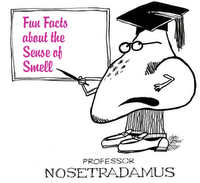
In my book chapter, CHC Theory: Past, Present, and Future (this is on-line version of a chapter published in Flanagan and Genshaft's 2005 CIA book) I alerted folks to the fact that the CHC taxonomy of cognitive abilities needed to be expanded to include tactile (Gh), kinesthetic (Gk), and olfactory abilities (Go) (click here). Many of my educational/school psychology colleagues have often asked me what possible relevance Go abilities would have for psychological assessment. To make a long story short, I have reminded my educationally-based friends and associates that cognitive assessments are used in many non-educational settings (e.g., aging research and clinical work; occupational settings; industrial settings; personnel selection settings, etc.).
In my 2005 chapter, I stated: "although largely ignored in structural investigations of human cognitive abilities, olfactory abilities (Go) are important to study given the use of the olfactory sense by blind or partially sighted people, and experts such as “gourmets, wine connoisseurs, coffee experts, and the like” (Danthiir, Roberts, Pallier, G. & Stankov, 2001, p. 357). In addition, recent clinical research has suggested that declines in olfactory abilities may be associated with a variety of clinical disorders and diseases ranging from Azheimer’s, idiopathic Parkinson’s, alcoholism and drug abuse, attention deficit/hyperactivity disorders, severe- stage anorexia nervosa, Down’s syndrome, head trauma, multiple sclerosis, restless leg syndrome, seasonal affective disorder, and others (see Doty, 2001, for a complete review)"
I have now run across two new empirical articles that continue to suggest that assessment and monitoring of Go abilities may be important for the possible early detection of eventual mental decline/disorders as well as helping us better understand the underlying neurological structural/functional mechanisms of certain mental/cognitive disorders. Both studies were published in the Journal of Experimental and Clinical Neuropsychology (2006, Vol 28). For those who want to be in the "nose", I've reproduced the references and abstracts below, along with links to the original articles. One articles deals with Go and schizophrenia while the other deals with Go and Huntingon's Disease
Larsson et al. (2006). Olfactory Functions in Asymptomatic Carriers of the Huntington Disease Mutation
- Huntington’s disease (HD) is a neurodegenerative disorder initially affecting the basal ganglia and especially the head of the caudate nucleus. Neuropsychological research has indicated that olfactory dysfunction may appear early in HD, prior to the onset of significant motor or cognitive dysfunction. The aim of this study was to examine whether asymptomatic carriers of the Huntington disease mutation also exhibit olfactory dysfunction. To address this issue we presented an extensive olfactory test battery comprising tasks assessing olfactory sensitivity, intensity discrimination, quality discrimination, episodic odor memory, and odor identification, to a group of gene carriers and nonmutation carriers of the disease. The results showed that gene carriers were selectively impaired in discriminating odor quality, although performance did not differ from noncarriers across the other tasks. The role played by striatum and then in particular the caudate nucleus for olfactory processing in general, and for odor quality discrimination in particular, is discussed.
Moberg et al. (2006). Olfactory Functioning in Schizophrenia: Relationship to Clinical, Neuropsychological, and Volumetric MRI Measures
- Deficits in odor identification and detection threshold sensitivity have been observed in schizophrenia but their relationship to clinical, cognitive, and biologic measures have not been clearly established. Our objectives were to examine the relationship between measures of odor identification and detection threshold sensitivity and clinical, neuropsychological, and anatomic brain measures. Twenty-one patients with schizophrenia and 20 healthy controls were administered psychophysical tests of odor identification and detection threshold sensitivity to phenyl ethyl alcohol. In addition, clinical symptom ratings, neuropsychological measures of frontal and temporal lobe function and whole brain MRIs were concurrently obtained. Patients exhibited significant deficits in odor identification but normal detection threshold sensitivity. Poorer odor identification scores were associated with longer duration of illness, increased negative and disorganized symptoms, and the deficit syndrome, as well as impairments in verbal and nonverbal memory. Better odor detection thresholds were specifically associated with first-rank or productive symptoms. Larger left temporal lobe volumes with MRI were associated with better odor identification in controls but not in patients. Given the relevance of the neural substrate, and the evidence of performance deficits, psychophysical probes of the integrity of the olfactory system hold special promise for illuminating aspects of the neurobiology underlying schizophrenia.
- Elsner, R. J. F. (2001). Odor memory and aging. Aging Neuropsychology and Cognition, 8(4), 284-306.
- Larsson, M., Oberg, C., & Backman, L. (2005). Odor identification in old age: Demographic, sensory and cognitive correlates. Aging Neuropsychology and Cognition, 12(3 ), 231-244.
- Lowen, S. B., & Lukas, S. E. (2006). A low-cost, MR-compatible olfactometer. Behavior Research Methods, 38(2), 307-313.
- Danthiir, V., Roberts, R. D., Pallier, G., & Stankov, L. (2001). What the nose knows: Olfaction and cognitive abilities. Intelligence, 29, 337-361.
- Miles, C., & Hodder, K. (2005). Serial position effects in recognition memory for odors: A reexamination. Memory & Cognition, 33(7), 1303-1314.
- Doty, R. L., & Kerr, K. L. (2005). Episodic odor memory: Influences of handedness, sex, and side of nose. Neuropsychologia, 43(12), 1749-1753.
Technorati Tags: psychology, educational psychology, neuropsychology, neuroscience, olfaction, olfactory, Go, CHC theory, CHC, intelligence, IQ, cognition, cognitive, tactile, kinesthetic, psychological assessment, psychological testing, schizophrenia, Huningtons disease, nose, smell, aging
powered by performancing firefox
